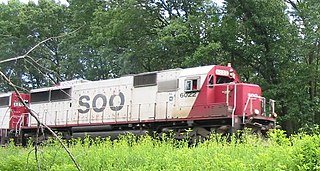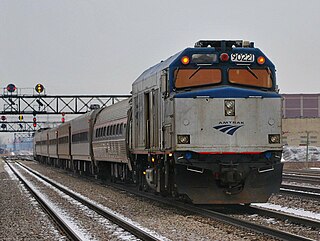
The Chicago, Milwaukee, St. Paul and Pacific Railroad (CMStP&P), often referred to as the "Milwaukee Road", was a Class I railroad that operated in the Midwest and Northwest of the United States from 1847 until 1986.

Saint Paul's Union Depot is a historic railroad station and intermodal transit hub in the Lowertown neighborhood of the city of Saint Paul, Minnesota, United States. It serves light rail, intercity rail, intercity bus, and local bus services.

The Soo Line Railroad is the primary United States railroad subsidiary of the Canadian Pacific Railway, one of seven U.S. Class I railroads, controlled through the Soo Line Corporation. Although it is named for the Minneapolis, St. Paul and Sault Ste. Marie Railroad (MStP&SSM), which was commonly known as the Soo Line after the phonetic spelling of Sault, it was formed in 1961 by the consolidation of that company with two other CP subsidiaries: The Duluth, South Shore and Atlantic Railway, and the Wisconsin Central Railway. It is also the successor to other Class I railroads, including the Minneapolis, Northfield and Southern Railway and the Chicago, Milwaukee, St. Paul and Pacific Railroad. On the other hand, a large amount of mileage was spun off in 1987 to Wisconsin Central Ltd., now part of the Canadian National Railway. The Soo Line Railroad and the Delaware and Hudson Railway, CP's other major subsidiary, presently do business as the Canadian Pacific Railway. Most equipment has been repainted into the CP scheme, but the U.S. Surface Transportation Board groups all of CP's U.S. subsidiaries under the Soo Line name for reporting purposes. The Minneapolis headquarters are located in the Canadian Pacific Plaza building, having moved from the nearby Soo Line Building.

Midway is a former Amtrak intercity train station in the Midway neighborhood of Saint Paul, Minnesota, United States. It was last served by Amtrak's daily Empire Builder and, for a time, by the North Star, as well as briefly by the North Coast Hiawatha.

The 400 was a named passenger train operated by the Chicago and North Western Railway between Chicago and Saint Paul, with a final stop in Minneapolis. The train took its name from the schedule of 400 miles between the cities in 400 minutes, and was also a nod to "The Four Hundred Club", a term coined by Ward McAllister to refer to the social elite of New York City in the late 19th century. It was an express train with limited stops between Chicago and the Twin Cities. The "400" ran from 1935 to 1963 on the Chicago to Twin Cities route. The C&NW later named their other passenger trains using the number "400".

The Olympian and its successor the Olympian Hiawatha were passenger trains operated by the Chicago, Milwaukee, St. Paul and Pacific Railroad between Chicago and the Pacific Northwest. The Olympian operated from 1911 to 1947 and was, along with its running mate the Columbian, the first all-steel train to operate in the Pacific Northwest. The streamlined Olympian Hiawatha operated from 1947 to 1961 and was one of several Milwaukee Road trains to carry the name "Hiawatha." The Olympian Hiawatha was designed by industrial designer Brooks Stevens and included the distinctive glassed-in "Skytop" observation-sleeping cars. It later featured full-length "Super Dome" cars.
The Columbian was a named passenger train operated by the Chicago, Milwaukee, St. Paul and Pacific Railroad between Chicago, Illinois, and Seattle/Tacoma, Washington. The westbound train was Milwaukee Road train #17, and the eastbound train was train #18.

Rondout is an unincorporated community in Lake County, Illinois, United States that first formed around a railroad junction. The area is located within Libertyville Township. As Rondout is an unincorporated community rather than a municipality, it lacks clearly defined borders, and shares postal codes with Lake Bluff, Lake Forest and Libertyville, Illinois. It has its own elementary school which comes under Rondout School District 72. Illinois Route 176 passes east–west through Rondout, serving as the "main street" of the community, where it is also called "Rockland Road".

The Twin Cities Zephyr was a streamlined passenger train on the Chicago, Burlington and Quincy Railroad (CB&Q), running between Chicago and the Twin Cities of Minneapolis and Saint Paul in Minnesota. It was the second Zephyr service introduced by CB&Q after the record-setting Denver–Chicago "dawn to dusk dash" of the Pioneer Zephyr trainset.

The Chicago, Milwaukee, St. Paul and Pacific Depot Freight House and Train Shed, now officially named The Depot, is a historic railroad depot in downtown Minneapolis, Minnesota, United States. At its peak, the station served 29 trains per day. Following decline, the station was closed and eventually adapted into various other uses.

The Minneapolis, St. Paul and Sault Ste. Marie Railroad (MStP&SSM) was a Class I railroad subsidiary of the Canadian Pacific Railway in the Midwestern United States. Commonly known since its opening in 1884 as the Soo Line after the phonetic spelling of Sault, it was merged with several other major CP subsidiaries on January 1, 1961 to form the Soo Line Railroad.

The Twin Cities Hiawatha, often just Hiawatha, was a named passenger train operated by the Chicago, Milwaukee, St. Paul and Pacific Railroad, and traveled from Chicago to the Twin Cities. The original train takes its name from the epic poem The Song of Hiawatha by Henry Wadsworth Longfellow. There are a number of Hiawatha-themed names within the city of Minneapolis, the terminus of the original train. The first Hiawatha ran in 1935; in 1939 the Milwaukee Road introduced a second daily trip between Chicago and Minneapolis. The two trains were known as the Morning Hiawatha and Afternoon Hiawatha, or sometimes the AM Twin Cities Hiawatha and PM Twin Cities Hiawatha. The Milwaukee Road discontinued the Afternoon Hiawatha in 1970 while the Morning Hiawatha continued running until the formation of Amtrak in 1971.

Zip Rail was a proposed intrastate passenger train that would link the Minneapolis–Saint Paul metropolitan area with the city of Rochester in the U.S state of Minnesota. The project was previously branded as Rochester Rail Link.

The Tomah Subdivision or Tomah Sub is a railway line that runs about 103 miles (166 km) from La Crosse, WI in the west to Portage, WI in the east.

The Watertown Subdivision or Watertown Sub is a 92.7-mile (149.2 km) railway line in Wisconsin operated by the Canadian Pacific Railway (CP) through its primary United States subsidiary, the Soo Line Railroad. It meets CP's Tomah Subdivision in the west in Portage and runs to Milwaukee in the east where it meets the C&M Subdivision. The Watertown Subdivision had previously been operated by the Chicago, Milwaukee, St. Paul and Pacific Railroad, though the Soo Line Railroad took it over when the Milwaukee Road folded. Canadian Pacific gained ownership via taking over Soo Line.

The Chicago and Milwaukee Subdivision is a 85.5-mile (137.6 km) railway line running between Chicago, Illinois and Milwaukee, Wisconsin. It is operated by the Canadian Pacific Railway through its primary United States subsidiary, the Soo Line Railroad. This had previously been owned by the Chicago, Milwaukee, St. Paul and Pacific Railroad, commonly known as the Milwaukee Road. It carries Amtrak's Empire Builder and Hiawatha Service, as well as commuter trains operated on part of Metra's Milwaukee District/North Line into Chicago. The Union Pacific Railroad operates their Milwaukee Subdivision, a former Chicago and North Western line, parallel to this route just to the east.

The Peninsula 400 was a daily express passenger train operated by the Chicago and North Western Railway between Chicago and Ishpeming, in Michigan's Upper Peninsula. It operated as a named consist from 1942 to 1969. It was one of the railroad's 400 passenger trains, whose name stemmed from the original '400-mile, 400-minute' express operated by the railroad between Chicago and Minneapolis–St. Paul.

The Kate Shelley 400 was a short-lived streamlined passenger train operated by the Chicago and North Western Railway between Chicago, Illinois and Iowa. The train drew its name from the CNW's popular Twin Cities 400, so-named for making the 400-mile (644 km) run from Chicago to Minneapolis, Minnesota in 400 minutes, and Kate Shelley, a young woman who in 1881 risked her life to save a passenger train from a washed-out bridge. The C&NW introduced the Kate Shelley to fill the void left by the Union Pacific Railroad's famed "City" streamliners, which had moved from the CNW's route to that of the Milwaukee Road. The Kate Shelley made its first run in October 1955. Initially it operated to Boone, Iowa, but this was cut back in 1956 to Cedar Rapids, Iowa, and then again in 1957 to Clinton, Iowa, just across the Mississippi River. The CNW dropped the name altogether on July 23, 1963, though the unnamed trains #1 and #2 continued running until the formation of Amtrak in 1971, when they were discontinued.
The Chippewa consisting of mostly conventional components, and later known as the Chippewa-Hiawatha, with a streamlined consist was a passenger train operated by the Chicago, Milwaukee, St. Paul and Pacific Railroad between Chicago, Illinois and Michigan's Upper Peninsula. It operated from 1937 to 1960. The Chippewa-Hiawatha was one of several regional trains to carry the "Hiawatha" brand.

The Copper Country Limited was a passenger train operated by the Chicago, Milwaukee, St. Paul and Pacific Railroad and the Duluth, South Shore and Atlantic Railway (DSS&A) between Chicago, Illinois and Calumet, Michigan, in Michigan's Upper Peninsula. It operated from 1907 to 1968.

















